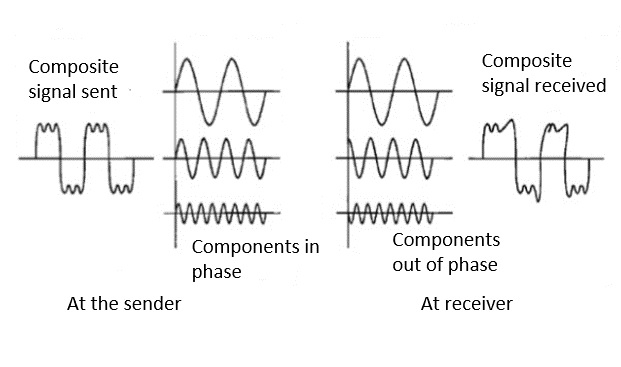
 Data Structure
Data Structure Networking
Networking RDBMS
RDBMS Operating System
Operating System Java
Java MS Excel
MS Excel iOS
iOS HTML
HTML CSS
CSS Android
Android Python
Python C Programming
C Programming C++
C++ C#
C# MongoDB
MongoDB MySQL
MySQL Javascript
Javascript PHP
PHP
- Selected Reading
- UPSC IAS Exams Notes
- Developer's Best Practices
- Questions and Answers
- Effective Resume Writing
- HR Interview Questions
- Computer Glossary
- Who is Who
What is Delay distortion in computer networks?
Transmission impairment occurs when the received signal is different from the transmitted signal. As we know, a signal can be transmitted as Analog signal or it can be transmitted as a digital signal.
In Analog signals due to transmission impairment the resulting received signal gets different amplitude or the shape. In the case of digitally transmitted signals at the receiver side we get changes in bits (0's or 1's).
Causes
There are various causes of transmission impairments, which are as follows −
- Noise
- Delay Distortion
- Attenuation Distortion
Let us discuss Delay Distortion.
Delay Distortion
This kind of distortion is mainly appearing in case of composite signals in which a composite signal has various frequency components in it and each frequency component has some time constraint which makes a complete signal.
But while transmitting this composite signal, if a certain delay happens between the frequencies components, then there may be the chance that the frequency component will reach the receiver end with a different delay constraint from its original which leads to the change in shape of the signal. The delay happens due to environmental parameters or from the distance between transmitter and receiver etc.
The delay distortion is diagrammatically represented as follows −

Refer the diagram given below −

Step 1 − In the above diagram, the delay distortion is due to velocity of propagation the frequency varies. Thus, various frequency components of a signal arrive at the receiver at different times.
Step 2 −: For digital data, fast components from one bit may catch up and overtake slow components from bit ahead, mixing the two bits and increasing the probability of incorrect reception.
Step 3 − Thus, it is difficult for digital data because signal components of bit positions spill into other bit positions, and so limit the allowed rate of transmission.

